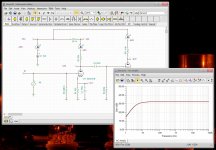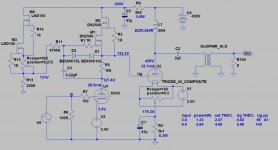Please think tube linearity in the context of its electrical environment. 6sn7 is ok as driver (not as voltage gain device) for 45 but for a better design it's not adequate.
As you wrote, it all depends on the "environment", i.e., on the operating point and how the tube is used. That said, I don't see why/how the 6SN7 would be generally inferior to (or better than) other tubes, and there is simply no good reason for bashing the 6SN7.
From the same quote from Jeff Corneff:Quote from Jeff Corneff:
'That 45 amp was a take off on Eric Barbour's Single Ended Glory for under $100. I attached that schematic. . . .'
-We are talking about two stage DHT amp, so the first stage is voltage amp as well driver for the output DHT.
-6sn7 gain is low for full output.
6sn7 is ok as driver (not as voltage gain device) for 45 . . .
"It's a power amp and will want a preamp ahead no matter that it could be driven directly from some sources. Seems to me the input sensitivity was around 2.6vac .. not sure now. But more than 2.5 and less than 3."
True. But if a high-gain first stage is used instead (D3a, E186F, C3g, etc.), the amp could be driven directly from the output of a DAC. No need for a preamp in this case, resulting in a quality gain (1-2 less preamp stages in the signal path - every stage adds its own distortion to the signal).
I used to have a Kornef 45 SET. What speakers you use will make or break, won't it? I wish I had it now to power my 111 dB sensitive compression drivers.
I have a pre-amp already. It is a Jack Elliano designed 6SN7 low-IMD. One of the best preamps I have yet to hear in my system, very transparent and dynamic. I would say very similar to Octal Aikido but Aikido had too much gain for my system. I am driving Lii Audio F-15's in full-range in OB can turn it up to uncomfortable levels. Choosing the 45 tube was a no-brainer for me. Choosing WHICH 45 amp was tougher! I saw several reviews that said the Korneff was by far the best with a preamp present. I tend to agree as it is better than my Tubelab SE 45. I also like the simplicity of the design as experience building has shown me that the fewer parts in the signal path the better things sound.
You're correct, of course, and I'm all for reducing the number of stages and parts, if possible. The SET I've got on the breadboard only uses two tubes per channel with a 26 input, although it's technically not a 2 stage amp since the power tube is a 6N6G.True. But if a high-gain first stage is used instead (D3a, E186F, C3g, etc.), the amp could be driven directly from the output of a DAC. No need for a preamp in this case, resulting in a quality gain (1-2 less preamp stages in the signal path - every stage adds its own distortion to the signal).
My point was that the amp was designed to use a preamp. If you design a 45 SET to use a preamp, there's nothing wrong with using the 6SN7. If you're designing a 45 SET that can be used without a preamp, you choose a different tube.
I used to have a Kornef 45 SET. What speakers you use will make or break, won't it? I wish I had it now to power my 111 dB sensitive compression drivers.
I also use a 45 Amp and I have 115db Oris Horns for the Amp to Drive. I also Bi-Amp with Hypex Amps on Klipschorn Bass Bins. Plenty of Power and of course that 45 Amp sound...
FlaCharlie.....not telling there is anything wrong. Since we are in diy I propose to try CCS/gyrator/Plate choke loaded ef184/e180f/c3m/e186f etc. and find if SQ improves for the user. If CCS/gyrator/plate choke not available a simple resistor load can be used initially. Of course the proposed mod should fit user's skill. Not doing and only theoretical discussion will not reach us anywhere.
Regards
Regards
Personally I use transformer output DHT pre with 2.5x gain. Since I use CD, Tape, tuner and LP as music source I need it for gain matching and proper drive.
Regards
Regards
ef184/e180f/c3m/e186f etc.
These tubes are super linear and provide a bit more gain than a good ole 6SN7. However, some of these tubes will typically end up with the grid at a DC bias of maybe -1.5 V or -2.0 V. Modern audio sources will therefore easily swing the AC signal into (or close to) positive grid voltage, which means grid current and distortion.
To prevent the grid current problem, I like to use tubes that allow a more negative DC bias. The 6SN7 is a good choice (if you ask me). If you want something else, take a look at the 6H30, which will easily work with a -5 V or -6 V DC grid bias: Tube Tester Files - 6N30P - 6H30П
6N30P has gain 15, so at 2V RMS input as standalone driver not optimal.
BTW sucks almost at least as much current as 45. 😛
BTW sucks almost at least as much current as 45. 😛
6N30P has gain 15, so at 2V RMS input as standalone driver not optimal.
I am not sure what you mean.
If the grid of the 45 tube is biased at -40 V or -50 V DC, it can swing 40 to 50 Vpk before it starts clipping. With a driver gain of 15, that would correspond to 2.6 to 3.3 Vpk. For a sine input, that's 1.8 to 2.4 Vrms. For non-sinusodial music, it's less than this (about 0.3 to 0.9 Vrms depending on the crest factor). In other words, a gain of 15 is just right to fully drive the 45 tube in such an application.
System choices and not keeping to standards make this a regular issue. This is what causes the ever returning "added preamp" necessity and causes people to add preamps in situations where they are definitely not needed. Worse is that such added "preamps" then are incapable driving standard loads. I recently experienced it again when I brought a power amplifier that could not be driven by the other peoples self created one offs (100 nF coupling caps at the output, really?). Apparently it is very hard to design for 1V rms for full output and to be able to drive 10 kOhm.
A never ending discussion but let's be glad that manufacturers make sources according standards. Then there is at least 1 constant factor.
A never ending discussion but let's be glad that manufacturers make sources according standards. Then there is at least 1 constant factor.
Last edited:
''I am not sure what you mean.
If the grid of the 45 tube is biased at -40 V or -50 V DC, it can swing 40 to 50 Vpk before it starts clipping. With a driver gain of 15, that would correspond to 2.6 to 3.3 Vpk. For a sine input, that's 1.8 to 2.4 Vrms. For non-sinusodial music, it's less than this
(about 0.3 to 0.9 Vrms depending on the crest factor). In other words, a gain of 15 is just right to fully drive the 45 tube in such an application.''
Please don't attack me it does not work like that. Moreover, data sheet mu not attainable with resistor load. We also should consider insertion loss. What works for me is if the output tube's grid is at -50 volt then the driver's mu should be minimum 30 and that is for CD's standard 2 volt rms output.
We
You can bias ef184/e180f/c3m/e186f etc. at about 180 volt plate voltage for 8-10 ma current, cathode at about 2.5 volt...been there done it many times.
If the grid of the 45 tube is biased at -40 V or -50 V DC, it can swing 40 to 50 Vpk before it starts clipping. With a driver gain of 15, that would correspond to 2.6 to 3.3 Vpk. For a sine input, that's 1.8 to 2.4 Vrms. For non-sinusodial music, it's less than this
(about 0.3 to 0.9 Vrms depending on the crest factor). In other words, a gain of 15 is just right to fully drive the 45 tube in such an application.''
Please don't attack me it does not work like that. Moreover, data sheet mu not attainable with resistor load. We also should consider insertion loss. What works for me is if the output tube's grid is at -50 volt then the driver's mu should be minimum 30 and that is for CD's standard 2 volt rms output.
We
You can bias ef184/e180f/c3m/e186f etc. at about 180 volt plate voltage for 8-10 ma current, cathode at about 2.5 volt...been there done it many times.
Make the design parameter 1V rms for full output (with 2V rms sources) and all is good. No matter what the explanation is, 2.8V rms input sensitivity is simply not OK.
Last edited:
- Home
- Amplifiers
- Tubes / Valves
- Korneff 45 Amp Circuit

